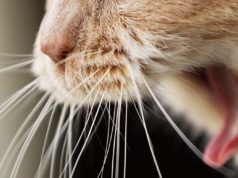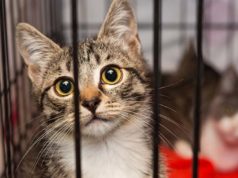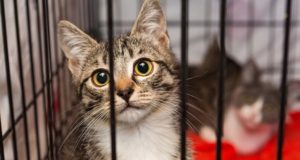It’s always hard to tell when your cat isn’t feeling well. Some of the most common cat diseases are much more prevalent than pet owners think, and they may affect your cat without you ever suspecting it.
 Since cats can’t tell their people when they’re in pain or not feeling well it’s up to the humans to keep a close eye on their cats and watch out for problems. Many of the most common cat diseases and health problems can be prevented. Many others can be treated at home.
Since cats can’t tell their people when they’re in pain or not feeling well it’s up to the humans to keep a close eye on their cats and watch out for problems. Many of the most common cat diseases and health problems can be prevented. Many others can be treated at home.
Knowing about, dealing with and preventing cat diseases is not only important for your feline pet, but also for you as a pet owner too:
“…cats can transmit disease to people, either directly through licks, bites, and scratches; indirectly by carrying other infection-laden critters like fleas and ticks into the human environment, or by shedding tiny infectious organisms into our environment through feces.” – Harvard Health (source)
The best way to keep your cat healthy and prevent most common cat diseases is to feed her a quality diet, make sure to use flea and tick preventative, and get your cat in to the vet once a year or twice a year for a regular checkup and vaccinations.
Furthermore, educating yourself on what are the most common cat diseases out there, their signs and symptoms, prevention and treatments will build an additional wall of security of your cat’s health. Here are the well-known cat diseases that you must be aware of.
For additional information, Center for Disease Control and Prevention has a full list of peer-reviewed papers on the most common cat diseases and what they mean. You can view the page right here.
25 Most Common Cat Diseases and How to Prevent Them
1. Cat Flea Dermatitis
Flea dermatitis in cats is one of the most common cat diseases around. It is an allergic reaction to the bites from fleas. Many cats have it. You may notice your cat scratching a lot, licking at their fur excessively, or being generally itchy and uncomfortable. You also might notice scabs or sores on your cat.
This can be prevented by using a good flea preventative like Frontline or Advantage all year long. Keeping your cat on a flea preventative is a good idea even if your cat doesn’t go outdoors. Fleas can get into your house on your shoes or pants or they can be brought in by visitors.
2. Hotspots in Cats
Hotspots in cats is another common cat disease that most pet owners will have to deal with eventually. Hotspots are one of the symptoms of flea dermatitis but they can be reactions to other things too. Hotspots are caused by allergies in cats.
If you notice that your cat is licking all the fur off of a paw, or picking at the fur on its sides or belly it could have an allergy. Food allergies are the most common cause of hotspots. Your vet can heal the reaction with a steroid injection and help you figure out what your cat is allergic to.
3. Vomiting
 Not as scary sounding as some other common cat diseases, vomiting is generally a sign of other health problems in your feline. Vomiting in cats can be caused by many different things. The most common cause of vomiting is just hairballs. Or eating dry kibble too fast.
Not as scary sounding as some other common cat diseases, vomiting is generally a sign of other health problems in your feline. Vomiting in cats can be caused by many different things. The most common cause of vomiting is just hairballs. Or eating dry kibble too fast.
If your cat vomits once and vomits up a little food or hair there’s probably no great need for concern. But if your cat is vomiting often or is vomiting up white foamy bile you should bring your cat to the vet. If your cat can’t any food or water down then it’s definitely time to get your cat to the vet to find the cause of the vomiting. The vet will also make sure your cat is staying properly hydrated.
Veterinarians may also look into your cat’s diet and determine whether your feline is sensitive to any type of foods you’re feeding her. Sometimes, they offer sensitive stomach cat food brands to try and fix the problem.
4. Runny Eyes and Cough
Runny eyes and coughs are usually due to an Upper Respiratory Infection in cats. Felines get them frequently, especially cats that are in multiple cat households. Just like humans can pass a cold around cats can pass URI’s around. Usually URI’s will go away on their own but if your cat isn’t getting better after a few days it’s a good idea to take your cat to the vet.
5. Not Using The Litterbox
Not using their litterboxes is less of a common cat disease but more of a behavioral problem at first. Despite what you may have heard, cats do not stop using the litter box out of spite. If your cat has never had litter box problems before but suddenly stops using the litterbox the cat is telling you that something is wrong.
It could be something simple like the box isn’t clean enough or the cat doesn’t like that kind of litter. But it could be serious. Take your cat to the vet if your cat stops using the litterbox and doesn’t start using it again after you clean it and change the litter.
6. Urinary Blockage
Urinary Blockage can be life threatening to cats. Male cats have a high risk for developing a urinary blockage and it’s one of the common cat diseases today. Male cats who are fed only a dry food diet have the highest risk of this painful blockage.
If you notice that your cat is straining to urinate, or if the cat cries or howls while urinating, or if you notice that not very much urine is coming out when the cat urinates get the cat to a vet right away. Left untreated urinary blockages can be fatal.
7. Obesity
 Obesity is becoming a big problem for cats and studies have found that the number of fat cats continues to grow. According to researchers at Cornell Veterinary University obesity in cats is on the rise and it can cause major health problems for cats.
Obesity is becoming a big problem for cats and studies have found that the number of fat cats continues to grow. According to researchers at Cornell Veterinary University obesity in cats is on the rise and it can cause major health problems for cats.
Heart disease, diabetes, and thyroid problems all can be caused by obesity in cats. Work with your vet to make sure that your cat doesn’t become obese. Make sure that your cat gets plenty of play time. And feed your cat a high quality diet that has the nutrients they need to stay healthy.
8. Dental Problem
Tarter buildup, broken teeth and other dental problems are very common cat diseases, and they can lead to infections, illnesses, and a painful mouth for your cat. Cats should get a thorough dental cleaning from a trained vet at least once a year to make sure that they don’t suffer from any dental problems.
9. Diarrhea
Diarrhea is another one of the most common cat diseases, and similar to vomiting, it’s usually a symptom of more serious health complications. Usually it will go away by itself. It’s often caused by switching a cat’s food too quickly, stress, or another illness.
If your cat has diarrhea make sure that your cat has access to plenty of cool water to drink. Cats lose fluids when they have diarrhea just like people do. If the diarrhea lasts longer than a couple of days take your cat to the vet to make sure that your cat doesn’t have worms or parasites and to make sure that your cat is staying hydrated.
10. Kidney Disease
 Kidney disease in cats is something that happens to many felines as they get older. The symptoms of kidney disease including vomiting and diarrhea, unexplained weight loss and lethargy. This is one of the most common cat diseases among senior felines. Low protein cat food brands are often recommended for cats with kidney problems.
Kidney disease in cats is something that happens to many felines as they get older. The symptoms of kidney disease including vomiting and diarrhea, unexplained weight loss and lethargy. This is one of the most common cat diseases among senior felines. Low protein cat food brands are often recommended for cats with kidney problems.
If your older cat is displaying any of these symptoms you should get your cat in to see a vet. A good way to prevent kidney disease later in life is to make sure that you always feed your cat a balanced high quality diet throughout the cat’s life.
11. Heartworm
Heartworm is usually considered more of a problem for dogs, but cats can get heartworm too. It’s not the most common cat diseases out there, but the risks are high if no precautions are taken in advance.
Heartworm in cats is caused by a bit from an infected mosquito. There is no cure for heartworm. You should give your cat a monthly heartworm preventative if you live in an area where there are lots of mosquitos. Even if your cat is an indoor cat it can still contract heartworm.
12. Feline Pancreatitis
Feline pancreatitis is something that can be deadly to cats and it’s one of the more common cat diseases that are very serious, and must be dealt with immediately. It is usually caused by feeding your cat food that isn’t high quality. But sometimes even foods from high end brands can cause pancreatitis.
Signs of pancreatitis in cats include weight loss and frequent vomiting. If your cat is vomiting up bile or blood and can’t keep food or water down take your cat to the vet immediately.
13. Cancer
Cancer is something that scares many cat owners and sadly, it’s also one of the more common cat diseases that veterinarians encounter today. Just like in humans it’s impossible to identify which cats will develop cancer.
If you notice that your cat has a lump that won’t go away, unexplained hair loss or weight loss, and general lethargy it is a good idea to get your cat screened for cancer.
14. FIV
FIV stands for Feline Immunodeficiency Virus and cats are the only animals to get this. The virus is one of the most common cat diseases found around, and it will slowly weaken and destroy the cat’s immune system so that the feline is unable to fight off even simple infections or colds. FIV can be dormant in your cat for years.
Some cats are born with it if the mother has FIV. Others contract it through the saliva of other cats when they are bitten by another cat or when they lick another cat and the cat licks them. There is a vaccine that all cats should have to protect them from FIV. But if your cat has FIV it’s not necessarily a death sentence. With a good diet and a lot of special care a cat with FIV can live a long and healthy life.
15. Feline Leukemia
Feline leukemia is another serious disease that cats can contract. Feline leukemia is something that one cat can pass to another so if you are bringing a cat into your home and you already have a cat, the new cat should always get tested for leukemia before you bring it into the house. Cats should be vaccinated for leukemia every year.
16. Feline Distemper
 Another one of the most common cat diseases that is actually more prevalent among dogs is Feline Distemper. Distemper is a kitten disease that can be fatal.
Another one of the most common cat diseases that is actually more prevalent among dogs is Feline Distemper. Distemper is a kitten disease that can be fatal.
It can cause bloody diarrhea, vomiting, lethargy and respiratory distress. Kittens should be vaccinated for distemper as soon as they are a few weeks old.
17. Rabies
This is something that every pet owner is usually aware of. Since it’s one of the most talked about common cat diseases out there, rabies vaccines are required by law in many places. There’s not much chance that your cat will contract rabies if the cat is an indoor cat but the cat still needs to get a rabies booster shot every year.
18. Worms
There are many different types of worms in cats that you’ll have to deal with eventually. Worms are gross, and they can cause serious health problems for your cat. Any cat can contract worms although cats that are outside cats or indoor/outdoor cats have a higher risk. Worms in cats can make them sick and cause skin lesions and other problems.
There are two main types of worms that cats can contract: ringworms and tapeworms. If you notice that your cat has circular sores or if you see small white things that look like grains of rice in the cat’s litterbox your cat could have worms. Ringworm can be passed to humans so it’s important to get your cat treated right away if you suspect your cat has worms. The vet can deworm a cat safely and quickly.
19. Urinary Tract Infection
Urinary tract infections are the most common cat diseases in males. Feeding your cat wet/canned cat food as well as dry food can help lower the risk of developing a urinary tract infection. If you notice your cat is straining to urinate, or cries out in pain when trying to urinate the cat could have a urinary tract infection. Antibiotics from the vet can cure a UTI.
20. Feline Diabetes
Late onset diabetes is something that is becoming more frequent in older cats, and that’s often the next stage after the aforementioned obesity disease. Years of rich diets without a lot of activity contribute to a cat developing diabetes and making it one of the most common cat diseases found in vet clinics today.
The good news is that diabetes is manageable and curable for most cats. It can also be easily prevented with proper diet and exercise. If you notice that your cat seems lethargic of unsteady and seems thirsty all the time get your vet to check the cat for diabetes.
21. Hyperthyroidism
Hyperthyroidism in cats is something that can occur with or without feline diabetes. A vet should be checking for hyperthyroid problems during your cat’s yearly physical. It’s not the most common cat diseases out there, but many pet owners have found it enough times to make sure that others are well-aware of this problem.
22. Abscess
An abscess in cats can occur when an untreated bite or scratch festers. Abscesses can also occur in the mouth because of broken teeth. Abscesses should be treated by a vet because they require draining and antibiotics to prevent infection. It’s one of the less common cat diseases out there, but knowing what to do in case you encounter this is smart.
23. Cuts or Bites
Every feline, just like every dog or child, will get bruised, get cut or even get bitten. While it’s not technically a disease by itself, what follows after may result in one of the most common cat diseases, such as infections and viruses.
Small cuts or bites can be treated at home with hydrogen peroxide. But deep wounds should always be seen by a vet so that they can be stitched up if necessary. Antibiotics are also a good idea if your cat has a bite or scratch from another animal.
24. Stomatitis
 Stomatitis in cats, also known as canker sores, is usually caused by poor dental hygiene or dental problems. This is one of the less common cat diseases, and many pet owners are surprised to find out that their feline may actually experience this.
Stomatitis in cats, also known as canker sores, is usually caused by poor dental hygiene or dental problems. This is one of the less common cat diseases, and many pet owners are surprised to find out that their feline may actually experience this.
Bacteria in the mouth leads to sores that get infected and make it painful for your cat to eat or drink. If your cat is having trouble eating and drinking get the vet to check the cat’s mouth. Antibiotics are often enough to clear up the problem but in rare cases the cat may need to have teeth removed to keep the bacteria under control.
25. Congestive Heart Failure
Congestive heart failure is something that happens frequently to older cats. It’s one of the most common cat diseases that results in early death of senior cats. Their hearts are not able to pump as efficiently as they used to and fluid builds up around the heart.
There are drugs that can help drain the fluid but congestive heart failure is not something that can really be cured. If you have an older cat that seems lethargic or is having trouble breathing get in to see the vet immediately so the vet can check for congestive heart failure. Feeding your feline proper senior cat food may also help to stave it off.
26. Anything else?
The above list contains some of the most common cat diseases known to pet owners. Have we missed something? Let us know in the comments below and let’s discuss.
READ NEXT: 25 Healthy Human Superfoods for Cats












